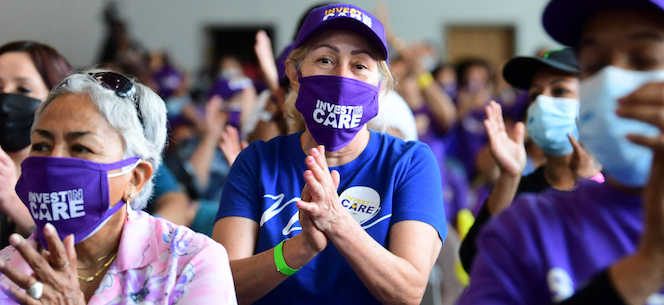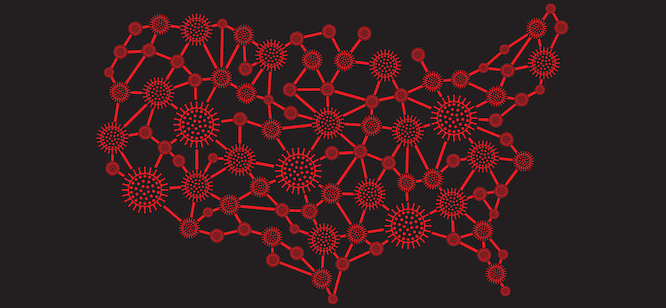
Despite the fact that we are in the midst of an unprecedented and deadly pandemic with no signs of abating, the right-wing majority on the Supreme Court appears unlikely to stop the carnage. The reactionary “justices” seem more inclined to shield corporate profits and red states’ rights than to protect the health and safety of the people.
Scientists have achieved near unanimity that vaccines and masking are effective in preventing COVID infections. Nevertheless, the high court is being asked to block Biden administration rules that would mandate vaccines and/or masking and testing. On January 7, the court heard arguments in two sets of cases that will have widespread impact on the health of millions of people in the United States.
The high court is not considering whether to strike down the mandates but rather whether to stop them from going into effect while the lower courts consider their constitutionality, which could take several months. Meanwhile, untold numbers of people are getting sick and dying.
Stephen Breyer noted that the day before the arguments, there were three-quarters of a million new COVID cases. “Can you ask us to say it’s in the public interest in this situation to stop this vaccination rule? … To me, I would find that unbelievable,” Breyer remarked to Scott Keller, attorney for the business associations challenging Biden’s vaccine-or-mask mandate.
Six Right-Wingers Poised to Stop Rule Protecting Workers
The first set of cases the court heard are subsumed under the name National Federation of Independent Business v. OSHA. Twenty-six business associations and attorneys general from 27 (mostly red) states are suing to stop the Occupational Safety and Health Administration (OSHA) from mandating that companies with more than 100 employees require their workers to get vaccinated or wear masks and submit to weekly COVID tests. As Sonia Sotomayor noted, this is not a vaccine mandate, since it presents a choice between vaccines and masking/testing. OSHA estimated that 40 percent of employers would opt for the mask-and-test policy.
Attorney Keller argued that the vaccine-or-mask mandate was “not a necessary, indispensable use of OSHA’s extraordinary emergency power.” Elena Kagan retorted, “It’s an extraordinary use of emergency power occurring in an extraordinary circumstance, a circumstance that this country has never faced before.”
Keller predicted that leaving the mandate in effect would cause “a massive economic shift” leading to “billions upon billions of non-recoverable costs” for businesses. He said Congress should have clearly given OSHA the authority to promulgate rules to combat COVID.
Pursuant to its authority under the Occupational Health and Safety Act, OSHA issued an “emergency temporary standard” to protect workers from viruses that pose “a grave danger.”
OSHA predicts that the rule would affect 84 million workers and would cause approximately 22 million people to get vaccinated. Estimates project that its implementation would prevent 250,000 people from being hospitalized. There is an exception for workers with religious objections and those who do not come into close contact with other people at their jobs or work substantially outdoors.
U.S. Solicitor General Elizabeth Prelogar told the court, “Workers are getting sick and dying every day because of their exposure to the virus at work. OSHA amassed substantial evidence of widespread workplace outbreaks across industries.” She said unvaccinated workers have a 1-in-14 chance of being hospitalized and a 1-in-200 chance of dying.
During argument, all six right-wing members of the court seemed inclined to side with the corporations and the red states. Conservatives suggested that OSHA exceeded its authority under the statute and the vaccine and/or masking requirements are more properly within the purview of Congress or the states (even though it was Congress that enacted the statute giving OSHA such power). They thought the rule was too broad as COVID is not a distinctly “occupational” danger.
By contrast, Sotomayor, Kagan and Breyer clearly favored protecting workers from the public health crisis caused by COVID. Kagan said, “I would think that workplace risk is about the greatest, least controllable risk with respect to COVID that any person has.” She added, “You have to be there. You have to be there for eight hours a day. You have to be there in the exact environment that the workplace is set up with. And you have to be there with a bunch of people you don’t know and who might be completely irresponsible.”
Kagan queried, “Why isn’t this necessary to abate a grave risk? This is a pandemic in which nearly a million people have died. It is by far the greatest public health danger that this country has faced in the last century. More and more people are dying every day. More and more people are getting sick every day.” Kagan noted that nearly a million people have died from COVID. “We know that the best way to prevent spread is for people to get vaccinated,” she stated, “and to prevent dangerous illness and death is for people to get vaccinated. That is by far the best. The second best is to wear masks.”
Indeed, the Centers for Disease Control and Prevention (CDC) found that unvaccinated people have a much higher risk of death than those who are fully vaccinated.
Sotomayor noted that some states are forbidding employers from requiring vaccines and certain states are stopping employers from requiring their employees to wear masks.
Breyer made clear he would allow the mandates to continue during the litigation, citing statistics for high rates of infections and deaths from COVID.
Chief Justice John Roberts said Congress did not specifically give OSHA power to impose a vaccine or test mandate and that OSHA had never before mandated vaccines.
Neil Gorsuch and Brett Kavanaugh — notorious opponents of deference to agencies that protect people — said the OSHA statute didn’t clearly authorize the agency to impose the mandate, considering the economic ramifications.
Gorsuch, the only member of the court present during arguments without a mask, said “the flu kills people every year,” and OSHA doesn’t regulate in that area. He erroneously stated that the flu killed hundreds of thousands of people annually. In fact, the flu kills between 12,000 and 52,000 Americans each year, according to the CDC.
Samuel Alito, who, like all of his colleagues on the court, is fully vaccinated, pointed out that there are “risks [of … adverse consequences” from the vaccines. “Serious side effects that could cause a long-term health problem are extremely unusual following any vaccination, including COVID-19 vaccination,” the CDC says, however. “The benefits of COVID-19 vaccination outweigh the known and potential risks.”
Alito derisively described OSHA’s interpretation as “squeezing an elephant into a mousehole,” strongly indicating he would refuse to allow the protective rule to go into effect.
Amy Coney Barrett thought that OSHA should have adopted a more targeted rule, saying this rule was too broad as it covered both dental employees and landscapers.
Clarence Thomas was not convinced that the mandate was “necessary.”
Right-Wing Majority May Well Halt Rule Protecting Medicare and Medicaid Patients
The second bloc of cases the court considered is Biden v. Missouri and Becerra v. Louisiana. They involve the fate of a directive promulgated by the secretary of the Department of Health and Human Services (HHS), which requires vaccinations for more than 17 million health care workers in facilities that accept Medicare and Medicaid. The rule contains an exemption for medical and religious reasons.
In these cases, a right-wing majority of the court may well strike down the mandate which would affect nearly half the country. But the votes are not as predictable as they are in the OSHA case.
Lawyers for the states challenging the rule argued that requiring vaccinations would cause health workers to resign from their jobs. “Rural America will face an imminent crisis,” stated Jesus Osete, Missouri’s deputy attorney general.
But Kagan responded that HHS had considered that eventuality before issuing the mandate. “I don’t know very much about the rural market,” Kagan acknowledged. “But the secretary” of Health and Human Services, “that’s his job.” Kagan added that many workers would feel safer coming to work if their coworkers were vaccinated. She noted that some people aren’t going to the hospital for mammograms and colonoscopies for fear of contracting COVID.
“The one thing you can’t do is to kill your patients. So you have to get vaccinated so that you’re not transmitting the disease that can kill elderly Medicare patients, that can kill sick Medicaid patients,” Kagan said. She called the elderly on Medicare and the poor who receive Medicaid “the most vulnerable patients there are,” adding, “Poverty has a great deal to do with medical outcome.”
Sotomayor noted that this rule was promulgated under the Spending Clause, affording the government wide latitude to impose conditions on the monies it disburses. Roberts appeared persuaded by this argument.
In a likely attempt to appear fair and balanced to protect the legitimacy of the Roberts Court, the chief justice seemed prepared to uphold the Medicare-Medicaid health care mandate. He maintained that it is closely related to COVID’s threat to health so it could be justified in an emergency.
Gorsuch appeared unmoved in his intention to strike down the mandate aimed at protecting Medicare and Medicaid patients. He echoed the states’ argument that the regulation “effectively controls the employment of individuals at these healthcare facilities in a way that Congress specifically prohibited.” Gorsuch characterized this use of money “as a weapon to control these things,” and suggested that it “should be left to the states to regulate.”
Kavanaugh also leaned toward blocking the rule, although he wondered aloud why “the people who are regulated are not here complaining about the regulation, — the hospitals and healthcare organizations. A very unusual situation. They, in fact, overwhelmingly appear to support the … regulation.”
Barrett objected that this was an “omnibus” rule covering ambulatory surgical centers as well as skilled nursing facilities. But she may have been swayed by the argument that Congress explicitly made provisions that the courts found objectionable severable, so those sections could be struck down without dooming the entire mandate. As Sotomayor pointed out, “the vast majority of the regulations across all facilities relate to health and safety.”
Thomas expressed worry about whether the vaccine “could have significant health consequences” and was troubled that the rule could preempt the issue in some states. Alito was concerned about prior notice to the states about the mandate.
Although Thomas and Alito seemed unsympathetic to the mandate, they questioned whether the states of Missouri and Louisiana had “standing” to sue on behalf of their citizens.
The Supreme Court Should Not Play Politics With Our Health
It is essential that the Biden administration’s mandates become operable to protect millions of people in the United States from illness and death. The response to the pandemic has fallen largely along political lines, so we cannot rely on the states to safeguard their residents.
Seven of the 10 states that have the highest number of deaths per 100,000 residents as a result of COVID are led by Republican governors.
Unvaccinated people tend to focus on their personal choice and not on the good of the whole. “But the point is that it’s not the risk to the individual that’s at question; it’s that risk plus the risk to others,” Sotomayor noted. “When you remain unmasked or unvaccinated, you put yourself at risk, but you put others” at risk as well.
This post was originally published on Latest – Truthout.

















